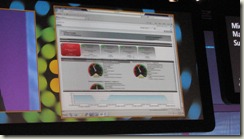MMS 2009 first day Keynote announcements

Bob Kelly (Picture by Andre Pronk)
At the 10th annual Microsoft Management Summit this week in Las Vegas, Bob Kelly (Corporate Vice President, Server & Tools Business) outlined an infrastructure strategy to help IT customers understand their options as they incorporate “the cloud” into Microsoft’s future plans.
Two Cloud models
Bob talked about the Cloud, and Microsoft sees two models: The Public and a Private Cloud. According to Bob, Microsoft will be one of the few companies who delivers the Public Cloud with their Windows Azure platform.
And secondly there is the Private Cloud which you should see as your internal Data Center. Think about Virtualization to conceptionalize what this means. Microsoft invests across their portfolio, everything from Windows, Forefront, System Center across optimizing your infrastructure and application platform, SQL, Biztalk, dotNet and SharePoint so they all have consistent and coherent API’s in the Private Cloud to the Public Cloud. Windows Azure is that implementation of that Microsoft stack in the Public Cloud. Microsoft took all those investments made in the On-Premise world and have taken those to the Public Cloud. And what they have learned in the Public Cloud and bring that to the Private Cloud. That will give Microsoft a unique position, in the way that there are very view companies that have the capacity and toolset to offer a platform that is deep and raw from Private Cloud to Public Cloud.
Microsoft will extend their investments, from the learning's they have in the Public Site to what they are doing on the Private site to ensure they have a platform that spans those two worlds and allows you to take advantages of thinks like AD, Security Infrastructure and Microsoft Management Infrastructure across both of that Public and Private Cloud build on Windows Server and System Center.
“Our goal is to give businesses the choice of running applications on-site, in the cloud or using a combination of the two,” says Kelly. “This hybrid model gives customers the best of both worlds — the scale and convenience of a public cloud and the control and reliability of on-premises software — and lets them move fluidly between the two based on their needs. It provides customers an on-ramp from their current IT environment to the cloud.”
[Soundbite here 4:27 mins)
Announcements:
Building on its cloud computing strategy, Microsoft made several announcements yesterday:
- System Center Operations Manager 2007 R2 will be available within 30 days.
[Soundbite here] - Availability of the Dynamic Datacenter Toolkit for Hosters [soundbite here]
Enabling the Foundation for Hosting Partners - Availability of the Dynamic Datacenter Toolket for Enterprises (within 90 days)
Enabling the Foundation for Private Clouds
More announcements can be found on System Center Central. Keynotes will be also be available for live and on-demand viewing here
Demo’s
During the keynote the next products where used to show how they support Microsoft’s Cloud strategy:
Windows Server 2008 R2. With investments in Hyper-V, Live Migration, Remote Desktop Services, IIS 7.5, Integrated IIS Extensions, ASP.NET on Server Core, PowerShell Management, PowerShell 2.0 and BPA.
Virtual Machine Manager 2008 R2. With investments in Automation of Live Migration, VM migration in SANs, Hot storage management.
Demo from Edwin Yuen about Managing the Fabric using a Visio Add-in to show Real Time Power Consumption and demoing Live Migration due to exceeding the Power Budget.Bill Morein demonstrated decoupling applications from the underlying operating system using application virtualization technology.
Operations Manager 2007 R2. With investments in Service level monitoring, cross platform monitoring, and live operational data in Visio diagrams.
Lorenzo Rizzi (Principal Architect System Center Operations Manager) demonstrated Service Level Dashboard 2.0 Beta for OpsMgr 2007 R2.

SLDV2.0 (Picture by Andre Pronk)